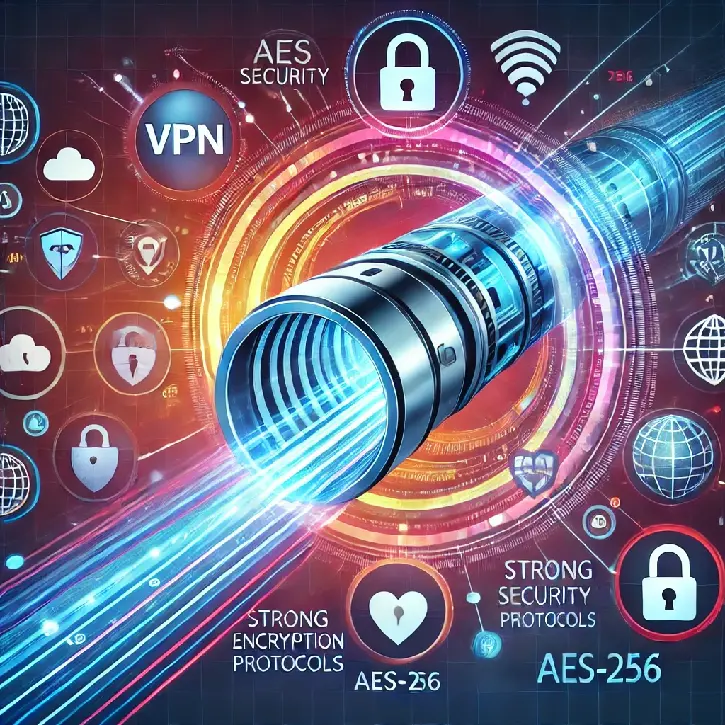Businesses rely heavily on Virtual Private Networks (VPNs) to secure their communication and protect sensitive data. However, the assumption that VPNs are inherently secure can lead to vulnerabilities that malicious actors can exploit. This blog delves into the importance of regular VPN security audits, providing a step-by-step guide on how to ensure your businesses VPN is truly secure.
The Importance of VPN Security Audits
A VPN security audit is a comprehensive assessment of your VPN's security posture. It involves identifying potential vulnerabilities, mis-configurations, and areas of improvement. Conducting regular VPN security audits is essential to maintaining the integrity of your border network and protect sensitive information from cyber threats. Here’s why VPN security audits are crucial for your business:
Ensuring Compliance with Industry Standards
Many industries are subject to strict regulatory requirements regarding data security and privacy. Regular VPN security audits will help to ensure that your business complies with relevant standards, such as GDPR, HIPAA, and PCI-DSS. By adhering to these regulations, you not only avoid potential fines and legal issues but also build trust with your customers and partners.
Identifying and Mitigating Vulnerabilities
Cyber threats are constantly evolving, with new vulnerabilities being discovered regularly. A VPN security audit helps to identify potential weaknesses in your VPN setup, such as outdated encryption protocols, mis-configurations, or weak authentication methods. By detecting these vulnerabilities early, you can take proactive measures to mitigate them before they are exploited by malicious actors.
Protecting Sensitive Data
The primary purpose of a VPN is to protect sensitive data as it travels over the internet. However, if your VPN is not properly secured, it can become a gateway for cyber-criminals to access your confidential information. Regular audits ensure that your VPN is configured correctly and uses strong encryption to safeguard your data from interception and unauthorised access.
Maintaining Network Integrity
A compromised VPN can lead to unauthorised access to your internal network, putting your entire IT infrastructure at risk. Regular security audits help maintain the integrity of your network by ensuring that only authorised users and devices can connect to your VPN. This reduces the likelihood of intrusions and helps prevent potential data breaches.
Enhancing Overall Security Posture
A VPN security audit is not just about identifying weaknesses in your VPN; it’s also about improving your overall security posture. The insights gained from these audits can inform your broader cyber-security strategy, helping you implement best practices across your entire IT environment. This holistic approach to security ensures that your business is better protected against a wide range of cyber threats.
Building a Culture of Security
Regular VPN security audits demonstrate your commitment to cyber-security to your employees, customers, and partners. By prioritising security, you foster a culture of vigilance and responsibility within your organisation. This culture encourages employees to be more aware of potential threats and to follow security best practices in their daily activities.
Key Areas to Focus On
Conducting a thorough VPN security audit involves several critical components. Each area needs careful examination to ensure that your VPN provides robust protection against cyber threats. Here are the key areas to focus on during your VPN security audit:

1. Configuration Settings
Proper configuration is the foundation of VPN security. Misconfigurations can introduce vulnerabilities that attackers can exploit. Key aspects to review include:
- Encryption Protocols: Ensure that strong encryption protocols, such as AES-256, are used to secure data transmission.
- IKE Settings: Verify that the Internet Key Exchange (IKE) settings are configured securely. Avoid using IKE aggressive mode with Pre-Shared Key (PSK) authentication, as it is more susceptible to attacks.
Default Settings: Change default settings and credentials to reduce the risk of unauthorised access.
2. User Authentication
User authentication is crucial in preventing unauthorised access to your VPN. Key considerations include:
- Multi-Factor Authentication (MFA): Implement MFA to add an extra layer of security beyond just a username and password.
- Access Logs: Regularly review access logs for any unusual activity or unauthorised login attempts.
- User Roles and Permissions: Ensure that users have the minimum necessary access required for their roles. Implement the principle of least privilege.
3. Network Traffic Monitoring
Monitoring network traffic helps detect potential security incidents in real time. Key actions to take include:
- Intrusion Detection and Prevention Systems (IDS/IPS): Deploy IDS/IPS to monitor and analyze network traffic for signs of malicious activity.
- Anomaly Detection: Use tools to detect anomalies in network traffic that could indicate a security breach.
- Logging and Analysis: Maintain detailed logs of VPN activity and regularly analyze them for patterns that could suggest an attack.
4. Patch Management
Keeping your VPN software and hardware up-to-date is vital for security. Key steps include:
- Regular Updates: Ensure that all VPN-related software and hardware are regularly updated with the latest patches.
- Vendor Updates: Subscribe to vendor updates and security bulletins to stay informed about new vulnerabilities and patches.
- Automated Patch Management: Implement automated systems for patch management to ensure timely updates.
5. Endpoint Security
The security of devices connecting to the VPN is equally important. Key considerations include:
- Device Compliance: Ensure that all devices connecting to the VPN comply with your security policies. This includes having up-to-date antivirus software and firewalls.
- Mobile Device Management (MDM): Use MDM solutions to manage and secure mobile devices that access the VPN.
- Endpoint Detection and Response (EDR): Implement EDR solutions to detect and respond to threats on endpoints.
6. Access Controls
Proper access controls help prevent unauthorised users from accessing your VPN. Key aspects to review include:
- Role-Based Access Control (RBAC): Implement RBAC to ensure that users can only access the resources necessary for their roles.
- VPN Gateways: Ensure that VPN gateways are securely configured and that access is restricted to authorised users only.
- Remote Access Policies: Define and enforce remote access policies to ensure secure VPN usage.
7. Regular Testing and Audits
Regular testing and audits help identify and remediate security weaknesses. Key activities include:
- Penetration Testing: Conduct regular penetration tests to identify vulnerabilities in your VPN infrastructure.
- Vulnerability Scanning: Use automated tools to scan for vulnerabilities in your VPN and related systems.
- Security Audits: Perform regular security audits to review and improve your VPN security posture.
8. IP Restrictions
Configure the VPN to allow connections only from specific trusted IP addresses, or country specific IP address allocations. This can be done using access control lists (ACLs) or firewall rules.
- Cisco ASA Example:
- Create an Access List:
access-list trusted_ips extended permit ip host 192.168.1.100 any
access-list trusted_ips extended permit ip host 192.168.1.101 any - Apply the Access List to the VPN:
crypto map outside_map 10 match address trusted_ips
crypto map outside_map interface outside
Defining the Scope of a VPN Security Audit
Defining the scope of a VPN security audit is a crucial step that sets the boundaries and objectives of the audit process. It ensures that all relevant aspects of the VPN infrastructure are examined, and resources are allocated efficiently. Here’s how to define the scope of your VPN security audit effectively:
1.Identify Objectives
Begin by clearly stating the primary objectives of the audit. What do you want to achieve? Common objectives might include:
- Identifying vulnerabilities in the VPN setup.
- Ensuring compliance: with industry standards and regulations.
- Evaluating the effectiveness: of current security controls.
- Improving the overall security posture: of the VPN infrastructure.
2. Determine the Scope Boundaries
Define what will and will not be included in the audit. This helps in focusing efforts and resources on the most critical areas. Consider the following elements:
- VPN Types: Specify whether the audit will cover remote access VPNs, site-to-site VPNs, or both.
- Components: Include all relevant components such as VPN servers, client devices, network infrastructure, and authentication mechanisms.
- Geographical Locations: Identify if the audit will cover all locations where the VPN is deployed or specific sites only.
3. Identify Stakeholders
List the key stakeholders who need to be involved in the audit process. This includes:
- IT and Security Teams: The primary executors of the audit.
- Management: Decision-makers who need to approve and support the audit.
- End Users: Individuals who use the VPN, whose behavior and devices may also need to be reviewed.
4. Inventory of Assets
Create an inventory of all assets that are part of the VPN infrastructure. This includes:
- Hardware: VPN servers, firewalls, routers, and switches.
- Software: VPN software, operating systems, and security tools.
- Endpoints: (if feasible) Laptops, mobile devices, and desktops that connect to the VPN.
- Network Segments: Different network segments that are part of or connected through the VPN.
5. Define Audit Criteria
Establish the criteria and standards against which the VPN will be evaluated. This may include:
- Compliance Standards: GDPR, PCI-DSS, etc.
- Security Frameworks: NIST, ISO 27001, CIS Controls.
- Internal Policies: Company-specific security policies and best practices.
6. Specify Audit Methods
Outline the methods and techniques that will be used to conduct the audit. Common methods include:
- Configuration Reviews: Examining the settings and configurations of VPN devices and software.
- Vulnerability Scanning: Using automated tools to identify vulnerabilities in the VPN infrastructure.
- Penetration Testing: Simulating attacks to identify potential security weaknesses.
- Log Analysis: Reviewing logs to detect unusual activities and potential breaches.
- User Interviews and Surveys: Gathering information from end-users about their practices and experiences with the VPN.
7. Timeline and Resources
Define the timeline for the audit, including key milestones and deadlines. Allocate the necessary resources, such as personnel, tools, and budget. Consider:
- Audit Duration: The total time required to complete the audit.
- Resource Allocation: Assign roles and responsibilities to team members.
- Tool Requirements: Identify and procure the tools needed for scanning, testing, and analysis.
8. Reporting and Documentation
Establish the process for documenting findings and reporting results. This should include:
- Interim Reports: Regular updates on the progress of the audit.
- Final Report: A comprehensive report detailing findings, recommendations, and action plans.
- Follow-Up: Procedures for follow-up actions and re-evaluation of addressed issues.
Tools used during a VPN Security Audit
Conducting a comprehensive VPN security audit involves a variety of tools designed to identify and mitigate potential vulnerabilities. Below, we outline several key tools:-
Tools
1. ike-scan
- Purpose: Scanning and identifying IKE services.
- Description: ike-scan is a command-line tool used to discover, fingerprint, and test IPsec VPN systems. It is particularly effective for identifying configurations that support Aggressive Mode.
2. psk-crack
- Purpose: Cracking Pre-Shared Keys (PSK).
- Description: psk-crack is used to perform dictionary and brute force attacks on captured IKE PSK hashes.
3. Hashcat
- Purpose: Advanced password cracking.
- Description: Hashcat supports multi-core and GPU-based cracking, making it highly effective for cracking complex hashes.
4. John the Ripper
- Purpose: Password cracking.
- Description: John the Ripper can be used to crack hashes obtained during a VPN security audit. It supports various hashing algorithms and is customisable for different attack modes.
5. IKEForce
- Purpose: Enumeration and brute-forcing IKE credentials.
- Description: IKEForce automates the process of enumerating valid group names and cracking PSK hashes, and can also brute-force XAUTH credentials.
Conclusion
Conducting a comprehensive VPN security audit is essential for safeguarding your organisations sensitive data and ensuring the integrity of your network infrastructure. By defining a clear scope, you can focus your efforts on the most critical areas, allocate resources efficiently, and set realistic objectives. Regular VPN security audits helps to identify vulnerabilities, ensure compliance with industry standards, and enhance the overall security posture of your organisation.
Understanding common vulnerabilities in VPNs, such as weak encryption protocols, insecure IKE configurations, and lack of user multi-factor authentication, enables you to take proactive measures to mitigate these risks. By regularly updating your VPN software and hardware, enforcing strict access controls, and monitoring using a SIEM comprehensive logs, you can effectively protect your VPN infrastructure from potential threats.




Categories